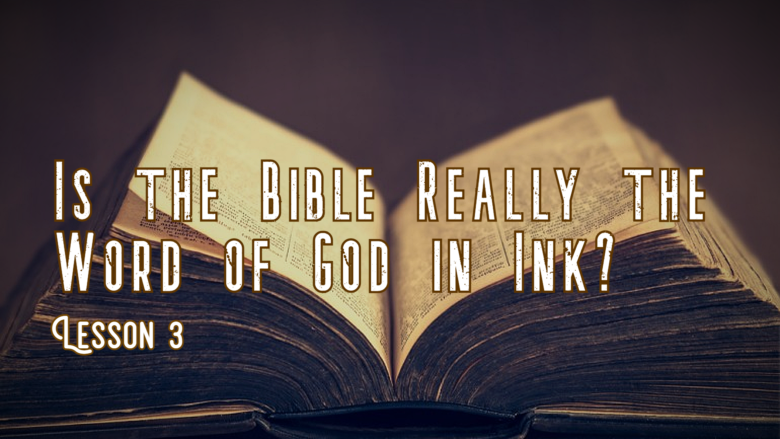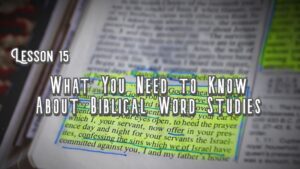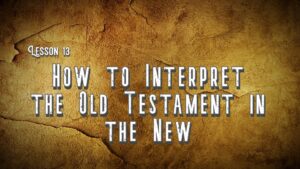Criticism of the Bible’s trustworthiness is perhaps at a peaking point in history. The late 1900s provided a battleground for new attacks on the Bible’s integrity, but the flaunt of relativism (discussed in Lesson 2) in the 21st century has taken these attacks a step further. So, we must ask the question, “Can the Bible be trusted as being the very words of God?” Many children have asked this question with the response given them, “Just have faith.” Such a response is sure to remove the last step in a stairway to confusion and doubt. Instead, let us give an able defense for the reason of the hope that lies within our hearts (1 Peter 3:15).
I propose to you: the Bible is the very out-breathed word of God. By “the Bible,” I do not mean to include the apocryphal (pseudonymous) books included in the Catholic Bible at the Council of Hippo in 393 A.D. Neither do I have in mind the Eastern Orthodox Bible which includes more Old Testament apocryphal books, written under pseudonyms during the 400 years between the Old and New Testaments. I refer to the 39 books of the Old Testament Hebrew Bible and the 27 books of the New Testament Christian Bible.
This is such a lengthy topic of discussion, that a Five Minute Bible Study can hardly serve it justice, but here we go. The discussion includes: 1. Does the Bible claim to be the word of God? 2. Is the Bible we have today the same as the Bible of the 1st and 2nd century? 3. Did man decide which books should be in the Bible? These and many other questions are worthy of response. For the sake of space and time, a basic answer will be given to each of these questions, with a list of resources at the end of this post for your further research.
1. Does the Bible claim to be the word of God?
2 Timothy 3:16-17 answers in the affirmative. The King James Version (KJV) translates vs. 16, “All scripture is given by inspiration of God…” while the Amplified and New International Versions say, “All scripture is God-breathed…” The latter renders the idea better into English. Literally, Paul is saying that God exhaled His words into the mind of the Bible writers. This is what Peter had in mind when he said, “For prophecy never came by the will of man, but holy men of God spoke as they were moved by the Holy Spirit,” (2 Peter 1:21).
“Scripture has a double authorship,”
says J. I. Packer (Comfort 31). By this he means, the Bible was penned by men, but the guiding influence was the Holy Spirit. This is manifest in the Bible’s own words, as the phrase “Thus says the Lord” is used some 359 times in scripture (Comfort 32).
2.Is the English Bible we have today the same as the Bible of the 1st and 2nd century?
The raw answer is no. This is inevitably the case when one language is translated into another language, as is the case with the Bible which was originally written in Hebrew, Aramaic, and Greek. The question then becomes, can the Bible be trusted? The answer is yes. The principles of inerrancy and infallibility need clarified in answering this question. Inerrancy means that something is perfect and without error. Infallibility means that something may have error but is still trustworthy. The original biblical manuscripts (hand written copies) were inerrant, while subsequent translations or copies are simply infallible. You may notice the secondary meaning for a word given in the center column reference of your Bible. This may imply that early manuscripts disagree on a word’s meaning, or the word has more than one possible meaning. This is an example where your modern English Bible may not be inerrant, but based on the truckloads of early, well preserved Bible manuscripts and other external proofs, we can be sure it is trustworthy.
This question about preservation of scripture entails more discussion on biblical manuscripts and the translation process. Suffice it to say, the Bible has hundreds more manuscripts, as well as, hundreds of earlier manuscripts than any other writing before or after it. There are just under 15,000 discovered and preserved New Testament manuscripts as of recent count (Geisler and Turek 225). For more information and studies on the transmission and preservation of scripture, see the Five Minute Bible Study video series— The Creation & Evolution of the Old Testament.
3. Did man decide which books should be in the Bible?
The simple answer is no. 2 Peter 3:15-16 acknowledges Paul’s epistles in the plural form, and also references them alongside, “the rest of the Scriptures.” Clearly there was already a practice of collecting the inspired writings in the first century while the Bible was still being written. Many naive souls will say the Bible canon (collection of books of the Bible) was collected and declared for the first time at the Council of Nicea (325 A.D.). That is blatantly false. The Council of Nicea was a Catholic council convened to affirm the deity of Christ. But neither is it true that this first took place at the Council of Hippo (393 A.D.), the Catholic council where church bishops put their authoritative stamp on which books should be included in the canon. Tertullian (2nd century Christian writer) was the first person recorded to call the collection of apostolic writings the “New Testament” in 190 A.D. (Comfort 66). Milton Fisher writes about the Catholic church’s declaration of the New Testament canon in the 4th century. He states,
“A need for officially defining the canon was not pressing until then (300s A.D.),”
(Ibid. 67). Paul warned the Christians at Thessalonica not to believe coming imposters who would write epistles in the names of the apostles, trying to deceive (2 Thess. 2:1-2). By the time of the Council of Hippo in 393 A.D., such imposters were at large, influencing the Catholic bishops to make an official statement about which books were authoritative and which were not. All of this to make the point: no pope, man named Tertullian, or church council decided which books should be included in the Bible. The inspired collection of Bible books was recognized prior to any uninspired man putting his stamp on the cover. My standing up in an audience of people and authoritatively declaring that the jar in my right hand is peanut butter does not make the item peanut butter. Peanut butter is what it is without my help. The same is true of the collective books of the Bible.
Hopefully you benefited from this study! This post only touched the skeleton of what is an enormous beast: the inspiration of the Bible. In our next study we will find out the answer to the question: how much of the Bible is authoritative now? For helpful resources on the topic today, check out the list on the next page or go listen to the audio sermon on fiveminutebiblestudy.com entitled— Can You Trust the Breath of God?
Homework Questions
1. How many books are in the Old Testament? How many books are in the New Testament?
OT = ____________
NT = ____________
2. What scripture teaches very clearly that the Bible is the word of God?
3. Define Infallibility—
4. Define Inerrancy—
5. What fact from this lesson is most convincing to you in building trust in the Bible?
Helpful Resources
The Origins of the Bible by Philip Comfort
I Don’t Have Enough Faith to Be an Atheist by Norman Geisler & Frank Turek



